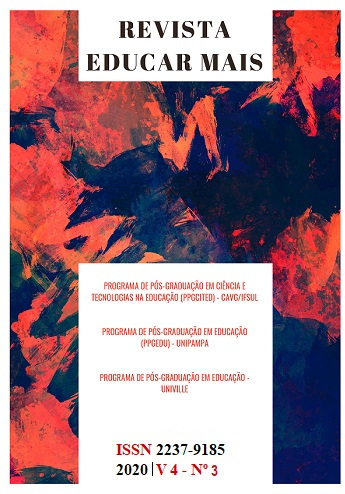Concepciones de los niños en edad preescolar sobre los fenómenos astronómicos
DOI:
https://doi.org/10.15536/reducarmais.4.2020.1924Palabras clave:
Día y noche, Fases de la Luna, Temporadas, Astronomía, Educación Infantil Temprana.Resumen
Este artículo tiene como objetivo investigar la percepción espacio-temporal de los niños en edad preescolar, a través del trabajo en el aula relacionado con los fenómenos día / noche, fases lunares y estaciones. Para ello, se aplicaron tres cronogramas de entrevistas, una por cada fenómeno, actividades de observación y registro del Sol y la Luna durante seis meses y una visita al planetario. La metodología de investigación empleada fue mixta, cuantitativa y cualitativa, utilizando la fenomenografía como método de investigación y, como instrumentos de recolección de datos, se utilizaron registros audiovisuales de las entrevistas, dibujos de los niños y notas del cuaderno de bitácora del docente sobre las observaciones. El análisis del diario y las entrevistas se realizó a través del análisis textual discursivo mientras que el análisis de los dibujos de los estudiantes hizo uso de la teoría de Piaget sobre las fases del dibujo infantil. Los resultados indicaron que la enseñanza de la Astronomía debe ajustarse cuidadosamente al grupo de edad de Educación Infantil, resultando de suma importancia, ya que los niños ya traen consigo un bagaje sobre estos fenómenos, asociado a sus vivencias diarias.
Descargas
Citas
ARCE, Alessandra; SILVA, Débora da; VAROTTO, Michele. Ensinando ciências na educação infantil. São Paulo: Alínea, 2011.
BOGDAN, Robert; BIKLEN, Sari. Investigação qualitativa em educação. Uma introdução à teoria e aos métodos. Portugal: Porto, 1994.
BORGES, Dária Lúcia de Jesus; STRIEDER, Roseline Beatriz. Ensino de astronomia na educação infantil: reflexões sobre a implementação de uma proposta. ENCONTRO DE PESQUISA EM ENSINO DE FÍSICA, 15. p.1 a 8, Maresias. Brasília, 2014.
BRASIL. Lei de Diretrizes e Bases. Lei nº 9.394/96, de 20 de dezembro de 1996. Estabelece as diretrizes e bases da educação nacional. Brasília, 1996.
BRASIL. Ministério da Educação e Desporto. Secretaria da Educação Fundamental. Referencial Curricular Nacional para a Educação Infantil. v. 3. Brasília: MEC/SEF, 1998.
BRASIL. Ministério da Educação. Secretaria da Educação Básica. Diretrizes Curriculares Nacionais para a Educação Infantil. Brasília: MEC, 2010.
BRASIL. Secretaria de Educação Fundamental. Parâmetros Curriculares Nacionais: ciências naturais. Brasília: MEC, 1997.
CANIATO, Rodolpho. A terra em que vivemos. Campinas: Átomo, 2007.
COMINS, Neli F.; KAUFMANN, William J. Descobrindo o universo. 8. ed. Porto Alegre: Bookman, 2010.
CURVAL, Ana; PEIXOTO, Ana. Olhar para o céu: a criança e a astronomia. Revista Interacções, n. 39, p. 653 - 666, 2015.
GOULART, Andressa Rossini; DUTRA, Carlos Maximiliano. Abordagem da astronomia no ensino fundamental através do software Stellarium. Brasil, 2012.
LANGHI, Rodolfo; NARDI, Roberto. Educação em astronomia. São Paulo: Escrituras, 2012.
LONGHINI, Marcos Daniel. Educação em Astronomia. Campinas: Àtomo, 2010.
MARRANGHELLO, Guilherme Frederico; LINDEMANN, Renata Hernandez. Ensino de ciências na região da campanha: contribuições na formação acadêmico- profissionais de professores em astronomia. Itajaí: Casa aberta, 2017.
MARTON, Ference, SÄLJÖ, Roger. On qualitative differences in learning II: outcome as a function of the learner's conception of the task. British Journal of Educational Psychology, 1976.
MORAES, Roque. Uma tempestade de luz: a compreensão possibilitada pela análise textual discursiva. Ciência & Educação: Bauru, São Paulo, v. 9, n. 2, p. 191 - 210, 2003.
MOREIRA, Daniel Augusto. O método fenomenológico na pesquisa. São Paulo: Pioneira Thompson, 2002.
PIAGET, Jean. A equilibração das estruturas cognitivas. Rio de Janeiro: Zahar,1976.
REIS, Pedro. Investigar e descobrir: actividades para a educação de infância em ciências nas primeiras idades. Chamusca: Edições Cosmos, 2008.
SARAIVA, Maria de Fátima Oliveira; AMADOR, Claúdio B.; KEMPER, Érico; GOULART Paulo; MULLER, Angela. As fases da lua numa caixa de papelão. Revista Latino-Americana de Educação em Astronomia, n.4, p. 9 - 26, 2007.
TIGNANELLI, Horácio. Sobre o ensino da Astronomia no ensino fundamental. In: WEISSMANN, H. (org.). Didática das ciências naturais: contribuições e reflexões. Porto Alegre: Artmed, 1998.
Descargas
Publicado
Cómo citar
Número
Sección
Licencia
Derechos de autor 2020 Educar Mais

Esta obra está bajo una licencia internacional Creative Commons Atribución-NoComercial 4.0.
DECLARACIÓN DE RESPONSABILIDAD: Certifico que participé de la concepción del trabajo, en parte o en la íntegra, que no omití cualesquiera ligaciones o acuerdos de financiación entre los autores y compañías que puedan tener interés en la publicación de este artículo. Certifico que el texto es original y que el trabajo, en parte o en la íntegra, o cualquier otro trabajo con contenido sustancialmente similar, de mi autoría, no fue enviado a otra revista y no lo será mientras su publicación esté siendo considerada por la Revista Educar Mais, sea en formato impreso o electrónico.
El autor responsable por el envío del trabajo representa todos los autores del mismo y, al enviar el artículo para la revista, está garantizando que tiene el permiso de todos para hacerlo. Del mismo modo, asegura que el artículo no viola derechos autorales y que no hay plágio en el trabajo. La revista no se responsabiliza por las opiniones emitidas.
La Revista Educar Mais es de acceso abierto (Open Access), sin que haya la necesidad de pagos de tasas, sea para submisión o procesamiento de los artículos. La revista adopta la definición de Budapest Open Access Initiative (BOAI), o sea, los usuarios poseen el derecho de leer, bajar, copiar, distribuir, imprimir, buscar y hacer links directos para los textos completos de los artículos en ella publicados.
Todos los artículos son publicados con la licencia Creative Commons Atribuição-NãoComercial 4.0 Internacional. Los autores mantienen los derechos autorales sobre sus producciones, debiendo ser contactados directamente si hay interés en uso comercial de los trabajos.
















